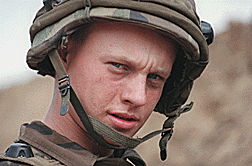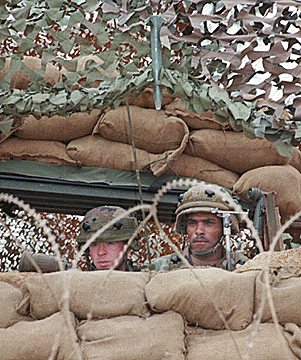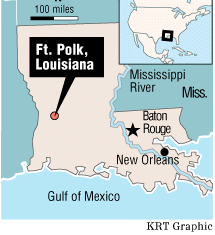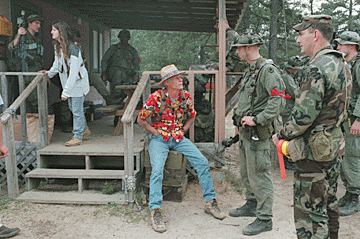


Part one | two | of two parts
Isle Troops Get Combat Ready
Since late January, some 3,800 Hawaii soldiers, mainly members of the 3rd "Bronco" Brigade of the 25th Infantry Division, have been in Fort Polk, La., on a massive peace-training operation.Joining them were an additional 2,000 soldiers, sailors and Marines from across the nation.
Honolulu Star-Bulletin reporter Gregg K. Kakesako and photographer Kathryn Bender traveled to Fort Polk to talk with soldiers about their roles in today's Army, which has struggled with downsizing and an evolving mission. And they got down and dirty to give readers an up-close look at the training from the trenches.
Tomorrow: "We try to make their life hell. If we succeed, we will make their life on the battlefield later much more easier," said one training officer. What the soldiers face.
By Gregg K. Kakesako
Star-BulletinFORT POLK, LA. -- Bigger pay raises for soldiers and the return of more-generous retirement benefits would be the first steps needed to improve today's Army.
But that's not enough, say several young soldiers of Hawaii's 25th Infantry Division (Light), now deployed for three weeks of peace enforcement training at the Joint Readiness Training Center here.

"I am more concerned about the standards," said Sgt. David Jones, 26, in the Army for four years."The standards are getting lower and lower. In the past the soldiers were better motivated and better driven. If you look into the past, we kicked butt because we were a hard Army."
Spec. Benjamin Widich, an Alpha team leader, said "the problem is we have started giving big bonuses for people to come in and go to college. A lot took the money and did not think they would have to be soldiers.
"They just said, 'I'll play the game and just run,' " said Widich, 27.
"Anyone who is motivated by money isn't one who will do a good job."
The soldiers are among the 3,800 "Lightfighters" from Schofield Barracks and Fort Shafter who left their Hawaii home base Jan. 28 to fly nearly 4,000 miles to central Louisiana. It is the unit's largest movement since the Tropic Lightning's peacekeeping mission to Haiti in 1994.
During a break in training, Hawaii soldiers interviewed by the Star-Bulletin last week applauded the decision by President Clinton and Pentagon brass to give them the largest pay raise in 15 years based on performance, not just longevity; 50 percent retirement for all soldiers; and increased commitment to readiness and modernization.
If Congress approves, the proposed 4.4 percent pay raise would take effect Jan. 1, 2000, for 480,000 active-duty soldiers, 450,000 Guardsmen, 205,000 Army reservists and 217,000 civilians.

U.S. Army Secretary Louis Caldera, in his first visit to Hawaii last month since becoming the 17th civilian head of the Army, said the proposed $110 billion spending package would provide the 4.4 percent pay increase in 2000 then a 3.9 percent increase annually for the next five years.The proposal also would:
Cancel the 1986 Redux law that set retirement at the 40 percent level, which covers about two-thirds of today's military, and would pave the way to raise retirement pay to 50 percent of base pay after 20 years of service.
Upgrade hardware such as the M-1 Abrahams tank and the Bradley Fighting Vehicle, and fund testing and evaluation of the Comanche helicopter and the self-propelled Crusader artillery system.
Staff Sgt. Gerado Avila, who has been in the Army for nearly eight years, said passage of the pay and retirement package would be factors in his decision to make the Army a career.
"Everything is up in the air," said Avila, 26. "If they pass the bill it would be an incentive to stay in."
Coping with Hawaii's high cost of living -- even with the benefit of living in military housing at Helemano -- is tough on a $1,800 monthly salary, he said.
"You can make it," said Avila, who is helping his wife get an associate degree from Leeward Community College, "but it could be better."
Spec. Aaron Sanchez, 21, said he wants to make the Army a career and has applied for warrant officer school hoping to fly the Army's new Comanche helicopter.

"It takes care of me and my wife," said Sanchez, who enlisted at 18 after graduating from high school in Las Vegas.But Widich said the drop in physical standards is what bothers him the most.
"There are people coming into the Army who are weak to begin with," said Widich, who marks his third anniversary in the Army in July, "and when things don't go the way they expect, they turn it into an IG (Inspector General) complaint.
"I'm in the infantry and there is no room for weakness."
It's the reduced retirement benefits that bother Jones, an Alpha team leader. "It used to be a good thing when my father was in the military and retired after 22 years. Those benefits were good then, but it's less now than what your parents got."
Operations
other than warSoldiers train for the mounting demands
By Gregg K. Kakesako
of humanitarian and peacekeeping
operations around the world
Star-BulletinIN this "schoolhouse" at this former World War II Army training base in an isolated part of central Louisiana, the soldiers have to deal with land mines.
But for the 25th Infantry Division from Hawaii, it's familiar terrain.
This is the second time the Schofield Barracks-based division has used the unique, complex training grounds at this 198,000-acre base.
In August 1994, the division's 2nd Brigade was the first Army unit to undergo peace enforcement training at Fort Polk -- a "free play" exercise designed to help commanders and subordinates identify belligerents, separate warring factions, mediate disputes, assist refugees and work with the United Nations and other private world relief organizations. Soldiers and civilians are contracted to play these "roles."
In the current training scenario that began Feb. 5 and runs through tomorrow, the brigade has been sent to the mythical island of Aragon, 2,000 miles off the southeastern coast of the United States. There, the 25th Division's job is to enforce a United Nations-negotiated cease fire and maintain a buffer zone between the countries of Cortina and Acadia.

This means the soldiers must keep apart the warring armies of the Cortinians and the Acadians -- and also deal with insurgents who terrorize local villages on both sides of the "zone of separation."This concept is what the Army calls "operations other than war," which trains today's soldiers to meet the mounting demands of humanitarian and peace operations in the world. The role-playing uses lessons learned from operations in Bosnia, Haiti and Somalia.
"The idea here is to give the foot soldier -- the guy out there with the rucksack and the M-16 -- all the training he needs," said Paula Schlag, Joint Readiness Training Center spokeswoman. "It's not training for a specific operation."
Still, this historical footnote: Six months after returning to Schofield five years ago from Fort Polk, Lt. Gen. George Fisher, then 25th Division commander, and Brig. Gen. Charles Swannack, then 2nd Brigade commander, were among the 3,700 Hawaii soldiers sent to Haiti to keep the peace as part of the 25th Division's Task Force Warrior.

Fort Polk facts
Established: 1941.
Named after: The Right Rev. Leonidas Polk, first Episcopal bishop of Louisiana.
Size: 198,000 acres.
Location: Seven miles southeast of Leesville.
Joint Readiness Training Center: Established 1987 at Fort Chaffee, Ark., then moved to Fort Polk in 1993, it combat-trains infantry.
Hawaii’s soldiers miss
By Gregg K. Kakesako
the sun, prepare
for the heat
Star-BulletinFORT POLK, LA. -- Fort Polk sits in an isolated area of meandering rivers and swamps, on 198,000 acres shared with alligators, wild pigs, fire ants and poisonous snakes. It's a far cry from the Big Island's volcanic cinder fields and puus where the Hawaii soldiers usually perform their extended training every summer.
And it can get downright cold.
"There was no snow," Chief Warrant Officer Donald Ah Nee recalled about his Jan. 31 arrival here with some dozen Hawaii Army National soldiers, most of them with the 29th Infantry Brigade (Separate). "It was just cold, down in the 20s and 30sand the weather changes from day to day."
"When we left Hawaii it was in the 80s. Then it was down in the 20s," Ah Nee said last week. "And, look, today it's somewhere in the high 70s -- almost like home. You just can't predict weather."
"I miss that warm sun," said Staff Sgt. Russell Wong of Pearl City, who got homesick watching the Pro Bowl on TV two Sundays ago. "I miss the tako (octopus) and the poke, but most of all my daughter Maryssa, my son Mason, and my wife Linda."
For the Hawaii Army National Guard dozen, being here now is just a warm up for June, when nearly 1,000 of their comrades will arrive for nearly three weeks of combat training at the Army's Joint Readiness Training Center. It will be one of 10 rotations or exercises the JRTC conducts annually to give active and reserve soldiers peace-keeping training.

And while 3,800 Schofield Barracks soldiers are undergoing such training now at Fort Polk, the Hawaii Army Guard dozen are getting ready for more traditional training in combat tactics, reacting to "a hot war" scenario this summer.For the next couple of weeks, Ah Nee's job as an ammunition supply specialist is to learn all he can working with his active-duty Army counterparts in the 25th Infantry Division
"My job is to ensure that soldiers in the field get the support they need," said Ah Nee, who has been in the Guard for 10 years. "My field is ammunition; there are other people worried about fuel, water, food and other crucial supplies.
"Without them you would lose the war. We have to get these crucial supplies to soldiers out in the front in a timely manner."
The most difficult part of this wartime scenario is communicating what is needed, Ah Nee said. As would occur in a combat situation, he is located in the rear of the 25th Division, away from the battlefield and relying on daily reports to keep the troops in the front supplied.
Wong, an 18-year veteran of the Hawaii Army National Guard, said he believes it will be tougher for Hawaii's citizen soldiers four months from now.

"There may be more heat casualties," the CH-47 Chinook helicopter mechanic predicted. "The heat and humidity are going to be big factors. We are going to need to hydrate the soldiers and warn them to take in more water."Then there are the snakes and wood and tree ticks. Personal hygiene will be a high priority."
Sgt. 1st Class Arturo Alcantara, Army adviser to the 29th Brigade's 2nd Battalion, Charlie Company on Maui, predicts his soldiers are ready, having spent the last two years preparing for the June event.
"I know the guys from Maui have trained hard and that the guys are really motivated," said Alcantara, one of 450 observer controllers evaluating the performance of the Schofield Barracks soldiers.
Capt. Woodrow Arakawa, a veteran of the 29th Brigade's deployments to South Korea in 1989 and Japan in 1995, said the pace has been hectic.

"I am finding out what works and what doesn't," said Arakawa, the brigade's property book manager.Even as the mercury climbed to nearly 80 degrees during last week's brief warm spell, Arakawa said Louisiana weather can be brutal during the summer.
"It'll be up in the 100s," said Arakawa. "That means we have to be on our guard for injuries such as from the heat."
Another islander serving as observer controller and evaluator is Capt. Steve Watai, 31, who is helping to prepare his California unit -- the 196th Infantry Brigade -- for a similar JRTC deployment exercise this summer.
Watai, a 1985 Mid-Pacific Institute graduate, has been in the Army since he graduated from the Citadel in 1989 and served in the 25th Division from 1990-94.